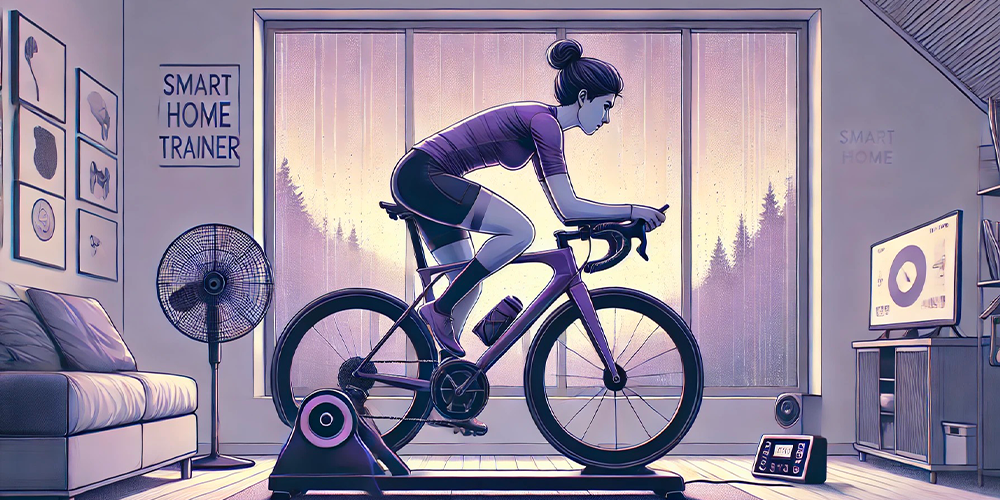For many cyclists, indoor sessions are not exactly the most enjoyable part of training. Yet they allow you to carry out specific, highly effective workouts that are perfect for working on quality.
Why train on the indoor trainer
Indoor trainers are used mainly from late autumn through winter, when cold, rain or lack of light make outdoor training difficult. But for many professionals, the trainer is not just an emergency solution: it is used all year round to create very precise training stimuli.
A key element is power measurement. Training with a power meter makes it possible to control intensity accurately and manage sessions more effectively. Knowing exactly how much power you are producing is also a huge source of motivation.
Mental training and motivation
Motivation is one of the most important elements of indoor training. Indoors you miss the pleasant distractions of outdoor riding, and your focus shifts entirely to the effort and to your body. Pain, fatigue and limits feel more evident — and this is exactly why trainer sessions are perceived as more intense.
For performance-oriented athletes, holding a set power level can be very motivating. 300 watts are always 300 watts on the meter, even if the perception differs from the road. If you can hit those numbers outside, you can maintain them on the trainer too. From a coaching perspective, indoor training is also an excellent tool for building mental strength. The brain plays a decisive role in managing power output and needs training just like a muscle. Recent studies confirm that the mind may be the most influential factor in an athlete’s overall performance.
To make the experience more bearable, external stimuli such as music or motivating images are helpful. Positive mental images — for example, recalling a successful race or a moment of satisfaction — can also make the effort feel lighter. This way, subjective perception combines with objective data like power output, creating an ideal balance.
Heart rate and overheating
Indoor training affects heart rate differently than outdoor sessions. Because of overheating, heart rate tends to rise progressively: when riding at 250 watts, the body produces roughly 1000 watts of total energy, only part of which turns into movement — the rest is released as heat (average muscle efficiency is around 25%).
To cool down, the body sends more blood to the skin, increasing heart rate. Heart rate can be distorted by overheating, so it should not be used alone to assess intensity. It is better paired with power data and perceived effort.
Good ventilation is essential — training near an open window or using a fan. When possible, moving the trainer outdoors is also an option.
Control and precision
In optimal conditions, power, cadence, load durations and recovery times can be monitored with precision. There is no traffic, no traffic lights and no terrain variation: you can work in total control. As mentioned earlier, this type of training also helps strengthen mental resilience.
Training cadence
Another parameter easily improved with indoor training is cadence. Most cyclists tend to pedal in the same range, but optimal cadence varies with power. In general, at higher power levels many cyclists prefer higher cadences, but the relationship varies from person to person. With targeted exercises, you can expand your range by working at cadences higher or lower than usual.
Session duration and intensity
The most effective indoor sessions are intensive, typically in zones Z3–Z5. Sessions of 30–60 minutes can be extremely efficient, while overly long workouts tend to reduce quality. It is better to focus on short but high-intensity sessions.
The 2PEAK program automatically adjusts session duration and intensity when switching from outdoor to indoor training, increasing overall efficiency. Trainer workouts also combine well with other disciplines in a cross-training context.
Cross-training examples
Circuit training
- 10-minute warm-up on the trainer.
- 10 minutes of circuit work with several stations (30–45 seconds each) followed by 15–30 seconds of recovery; alternate muscle groups: push-ups, jump rope, sit-ups, squats, pull-ups, jumps, etc.
- 10-minute cool-down.
Complement to an endurance session
- VO2max intervals added to an easy outdoor winter endurance ride.
Recovery ride
- Short spin on the trainer after a ride to promote muscle recovery.
Advantages and disadvantages of indoor training
Advantages
- Precise monitoring of power and cadence.
- Independence from weather, traffic and terrain.
- Direct comparison between sessions (without external influences).
- Training effects more clearly visible.
- Training of mental strength and focus.
- Maximum time efficiency.
Disadvantages
- Risk of overheating.
- Heart-rate drift.
- Monotony and mental fatigue.
- Higher perceived effort.
- Less natural pedalling sensation (depending on the trainer model).
Tips for effective indoor training
- Train with a structured plan or program.
- Prefer short but intense sessions.
- Use a reliable power meter.
- Do not rely solely on heart rate.
- Ensure good ventilation to avoid overheating.
- Avoid overly long or unfocused sessions.
